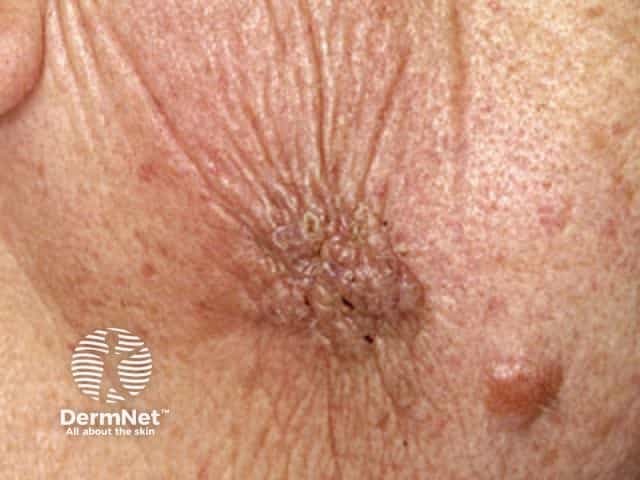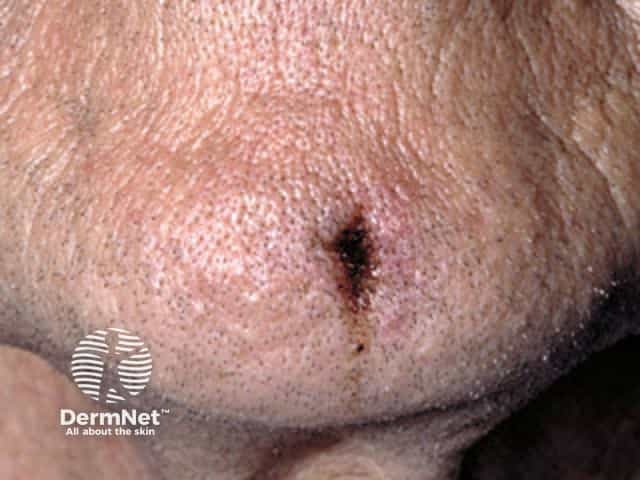Main menu
Common skin conditions

NEWS
Join DermNet PRO
Read more
Quick links
Introduction
Demographics
Clinical features
Diagnosis
Treatment
A dental sinus is an abnormal channel that drains from a longstanding dental abscess associated with a necrotic or dead tooth. A dental sinus may drain to:
Intraoral dental sinuses are the most common form and the majority of necrotic teeth have been reported to drain this way.
A dental sinus usually results from a chronic infection in longstanding necrotic dental pulp (a dead tooth). The decay is usually due to caries or trauma. Caries occur due to poor dental hygiene and regular consumption of refined sugars. Other predisposing factors to dental decay include:
Infection is more likely after endodontic work, and in patients that are immunosuppressed, having chemotherapy or suffering from blood dyscrasias.
The direction a sinus takes either within the mouth or to the skin is determined on which tooth is involved and follows the path of least resistance – the thickness of the bone as well as muscle attachments and fascial planes direct the route of drainage.
Intraoral dental sinuses usually occur in the sulcus on the cheek side near the tip of the tooth involved.
The majority of extraoral dental sinuses start from a tooth in the lower jaw and drain to the chin or under the chin or jawline (submental or submandibular area). Those originating from a tooth in the upper jaw may drain to the cheek or close to the nose. The site of an extraoral sinus opening is often at quite a distance from the infected tooth.
The infected necrotic pulp may cause severe toothache before the sinus or fistula develops. Disappearance of the pain without dental treatment, can be an important clue that the abscess has drained and formed a sinus. However, the process can also occur painlessly.
Intraoral dental sinus may appear as a persistent mouth ulcer that drains pus, causing a bad taste in the mouth. Extraoral dental sinus may present as a persistent, draining sore or as a lump on the face. It is usually painless. The discharge may be pus or blood-stained. The sinus opening may be observed on careful examination.
Because toothache is usually absent, the patient frequently presents to a doctor rather than a dentist. As extraoral dental sinus is a rare condition it is often misdiagnosed initially as a more common skin condition such as a skin cancer, boil or other skin infection, pyogenic granuloma, trauma, foreign body or other granuloma, cyst or one of the other forms of face and neck sinuses and fistulae.
Recurrence despite antibiotics or surgery is a clue to the correct diagnosis.
An obviously decayed tooth in the mouth or a history of a deep filling usually suggests which is the offending tooth. The relevant tooth may be discoloured or tender when tapped. There may be evidence of previous dental or endodontic work or of poor oral hygiene generally.
However, a tooth can have a filling for many years before dying painlessly and so examining the teeth clinically may not show any obvious abnormality. The tooth may not respond to cold or electric pulp testing (pulp vitality testing /pulp sensibility test).
Dental abscesses may also be complicated by osteomyelitis (infection of the bone), cellulitis (redness, swelling) or a facial abscess. Head or neck lymph nodes may be enlarged. It is very important to attend to a facial swelling promptly as the infection may spread to other parts of the body or may endanger the airway.

Dental sinus

Dental sinus
View more images of odontogenic cutaneous sinus tracts
The clinical clues should be:
Radiology (x-ray) is the most important investigation, as it will usually show an area of bone loss around the root tip of the chronically infected tooth. When the involved tooth is not obvious, a gutta-percha (rubber) point may be inserted into the sinus to track its course back to the relevant tooth. Rarely CT scan or MRI is required.
If possible, surgery should be avoided as it will not solve the problem and can result in unnecessary scarring. Biopsies (if taken) may be reported as showing abscess, granuloma or an epithelium-lined tract.
A variety of bacteria may be isolated from a swab including strictly anaerobic gram negative rods and aerobic gram-positive cocci.
Removal of the entire tooth (extraction) or necrotic dental pulp (root canal / endodontic treatment) is the only successful treatment for a dental sinus.
Antibiotics such as penicillin or metronidazole may be also required.
The sinus will usually heal 1–2 weeks after extraction or successful endodontic treatment. There may be residual scarring if biopsies or surgery had been performed. Otherwise there might be a slight dimple or skin surface colour change that usually improves with time.